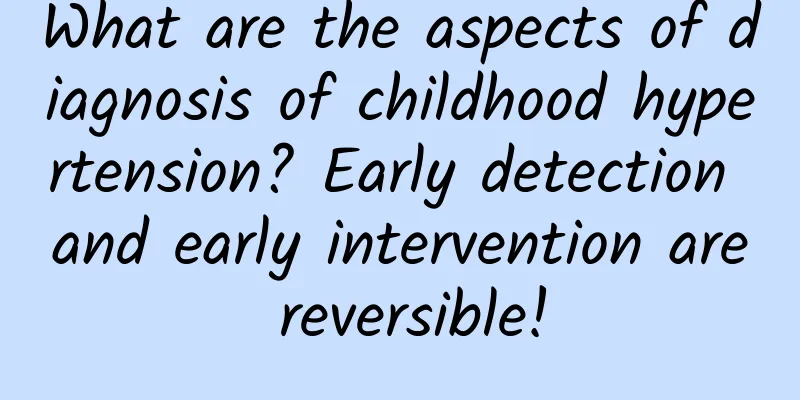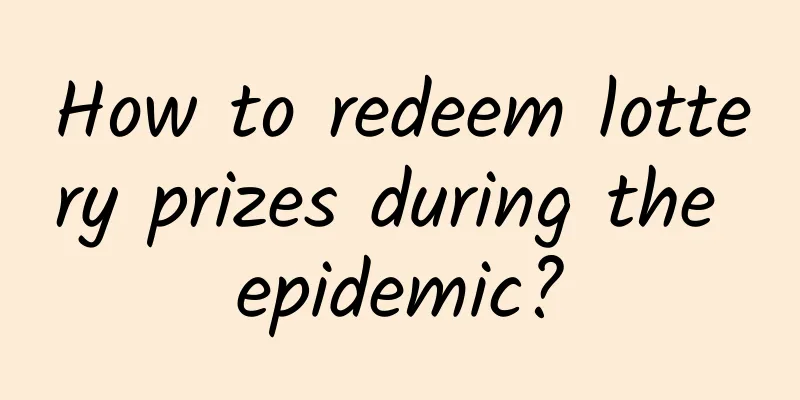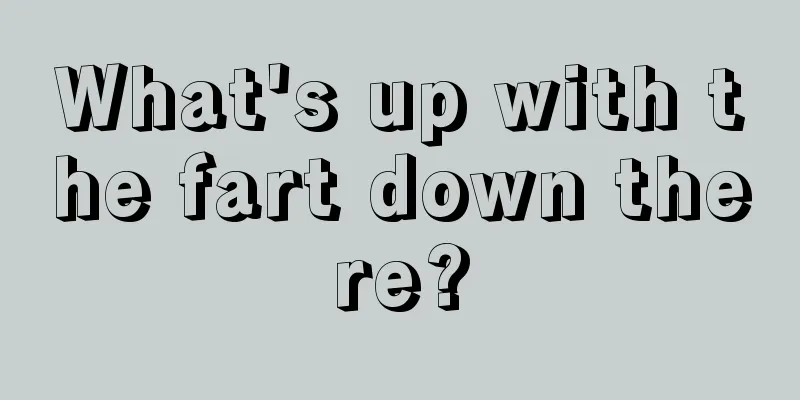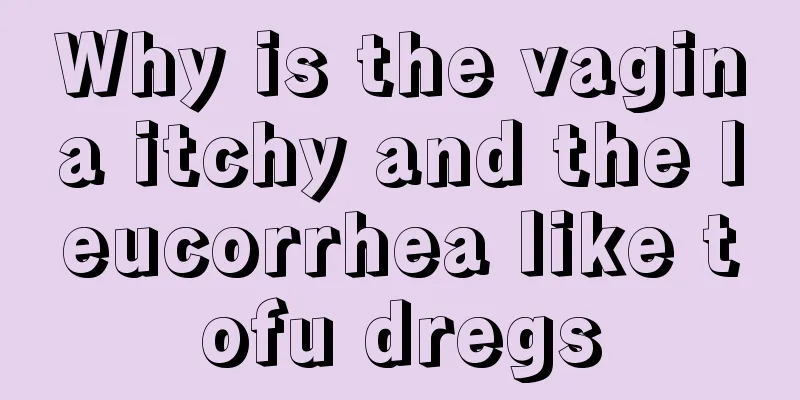What are the aspects of diagnosis of childhood hypertension? Early detection and early intervention are reversible!

|
Author: Li Xiaohui, Chief Physician, Children's Hospital, Capital Institute of Pediatrics Reviewer: Meihua Park, Chief Physician, Peking University Third Hospital Hypertension in children is not easy to detect because there are no specific symptoms in the early stage. For young children, they may not express physical discomfort; and for older children, due to the hidden onset of hypertension, the symptoms are not easy to detect. The typical manifestations of hypertension are headaches, dizziness, nausea, vomiting, weight loss, and even developmental impairment. Figure 1 Original copyright image, no permission to reprint If a child has risk factors for high blood pressure, such as obesity or a family history of high blood pressure, parents should pay attention to regularly monitoring their child's blood pressure to ensure early detection, early diagnosis, and early intervention. The diagnosis of hypertension in children is based on the percentiles of age, sex and height. For children aged 3-15, the 95th percentile (P95) of blood pressure corresponding to age, sex and height in the "Reference Standards for Blood Pressure by Sex, Age and Height for Children Aged 3-17 in China" is used as the judgment boundary, that is, systolic blood pressure and/or diastolic blood pressure ≥ P95 is diagnosed as hypertension; for children aged 16-17, since their height and sexual development are similar to those of adults, the adult hypertension standard can be directly used, that is, systolic blood pressure and/or diastolic blood pressure ≥ 140/90 mmHg is diagnosed as hypertension. The diagnosis of hypertension in children is based on three consecutive blood pressure measurements, which must be performed on different days with at least two weeks between each measurement. Hypertension is diagnosed only when the blood pressure values measured three times on different days are ≥95th. However, if the blood pressure values measured occasionally reach moderate to severe hypertension, that is, systolic and/or diastolic blood pressure ≥P99+5mmHg for children aged 3-15 years, and systolic and/or diastolic blood pressure ≥160/100mmHg for children aged 16-17 years, hypertension can be directly diagnosed. The diagnosis of hypertension in children needs to consider four aspects: blood pressure level and hypertension classification, cause of hypertension, target organ damage and degree, and other cardiovascular diseases and complications. First, children's blood pressure values between P90-P95 or ≥120/80mmHg are considered high normal blood pressure; ≥P95 is diagnosed as hypertension. Children's hypertension classification: Grade 1 hypertension: (P95-P99)+5mmHg; Grade 2 hypertension: ≥P99+5mmHg. Second, the causes of hypertension are divided into primary and secondary. For those with clear causes, such as kidney disease, endocrine disease, rheumatic autoimmune disease, blood tumors and drugs, they are secondary hypertension. In other words, high blood pressure is the clinical manifestation of the above diseases, or the high blood pressure level caused by the above diseases. For those without clear causes, they are called primary hypertension. Risk factors for primary hypertension include: obesity, family history of hypertension, and psychological and mental stress. Third, target organ damage caused by hypertension refers to structural or functional changes in the heart, kidneys, brain, and fundus, including hypertensive heart disease, decreased renal function, fundus hemorrhage, cerebral hemorrhage, etc. Fourth, other cardiovascular diseases and complications, such as large vessel disease, diabetes, etc. Treatment of hypertension in children includes causal treatment and symptomatic treatment. For secondary hypertension, priority is given to causal treatment. As the primary disease is treated or controlled, blood pressure levels will also be controlled. For example, after surgical resection of pheochromocytoma, the body will no longer secrete catecholamines, and blood pressure will drop; for example, renal vascular stenosis, after interventional treatment to improve vascular stenosis, blood pressure will also improve. For primary hypertension, if no clear cause can be found, symptomatic treatment should be considered. Through non-drug and drug treatments, blood pressure levels can be controlled within the normal range to prevent and reduce target organ damage. Primary hypertension in children often presents as grade 1 hypertension, and non-drug treatment is the first choice. It is clear that obesity is an independent risk factor for primary hypertension, which can lead to metabolic and endocrine disorders, thereby causing high blood pressure. Blood pressure can also be improved by improving lifestyle, including that obese children should control their weight, while ensuring height development, delaying the rising trend of body mass index and reducing body fat content; increasing aerobic and resistance exercise, reducing static activity time; adjusting dietary structure and variety diversification, controlling total energy and fat energy supply ratio; controlling dietary salt and sugary drink intake according to WHO's recommended standards for children, and developing healthy eating habits; avoiding persistent mental tension; ensuring adequate sleep time, etc. However, if blood pressure is still not up to standard after 6 months of intervention, drug treatment can be initiated while continuing lifestyle intervention; during the period of lifestyle intervention, if blood pressure rises to grade 2 hypertension or clinical symptoms appear, drug treatment should also be carried out. Figure 2 Original copyright image, no permission to reprint Indications for drug treatment of hypertension in children include: ① the appearance of clinical symptoms of hypertension (dizziness, headache, nausea, vomiting); ② diabetes; ③ secondary hypertension; ④ target organ damage. The principle of drug treatment for hypertension in children is to start with a small dose and a single drug, taking into account individualization, and then use a combination of drugs if the antihypertensive effect is not ideal. Considering the compliance of medication and reducing adverse drug reactions, it is best to give children long-acting antihypertensive drugs, which can reduce the number of medications and maintain the efficacy of the drugs. Children with hypertension can stop taking medications according to their medication situation if they meet the indications for reducing or stopping medications during clinical treatment. For example, by improving lifestyle, developing healthy eating habits, and increasing aerobic and resistance exercise, weight can be reduced, blood pressure levels can be lowered, and gradually stabilized. Medication can be stopped and does not need to be taken for life. It should be noted that antihypertensive drugs cannot be stopped abruptly and need to be reduced or stopped under the guidance of a doctor. With the popularization of medical knowledge, including school physical examinations, many children with hypertension can be discovered at an early stage and their blood pressure can be improved by active intervention. |
<<: It’s “eye-catching”, what should I do?
>>: Under the Feathers: The Inextricable Relationship between Salmonella Typhimurium and Pigeons
Recommend
How long is it normal for menstruation to be delayed?
Menstruation has always been a physiological phen...
What does HMG mean?
Many people are not clear about what HMG is. What...
Molar pregnancy is the cause of male and female
Some people may have heard of such a strange phen...
No bleeding on the 5th day of medical abortion, endometrial thickening
If there is no plan to have a baby in the short t...
What should women eat for cold body? How to treat cold uterus? What should women eat?
Cold body also means cold constitution, which is ...
What is the middle part of the breast?
Both men and women usually have two breasts, but ...
How to fix the fishy smell in duck soup How to fix the fishy smell in duck soup
We all know that duck soup is a common nourishing...
Precautions after biochemical pregnancy
Nowadays, many women choose biochemical pregnancy...
What is the difference between hip and waist?
First of all, how to calculate the hip circumfere...
Urine leakage? ! It is a disease and needs to be treated!
Female friends asked: “Is it normal to cough, sne...
Farting during early pregnancy means it's a boy
In the eyes of many people, the gender of the fet...
Why don't you have your period?
The biggest physiological characteristic of women...
What is Cassia Seed? The difference between raw Cassia Seed and cooked Cassia Seed
Cassia seed, also known as grass cassia, horse ho...
How to remove postpartum pregnancy spots
To remove pregnancy spots after childbirth, you n...
What should women do if they suffer from anal fissure itching?
What should women do if they suffer from anal fis...









